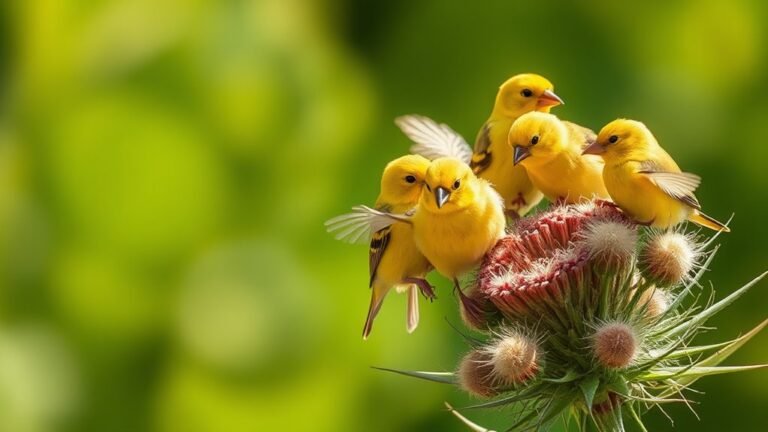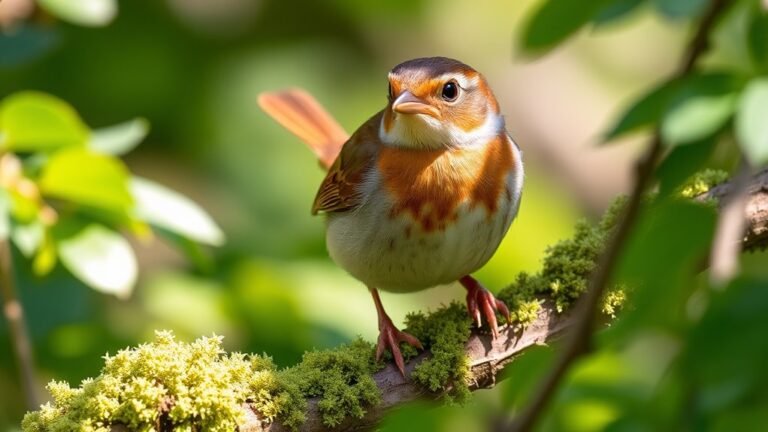Birds That Lay Blue Eggs: Complete Species Guide
Blue eggs in birds are not just beautiful; they play important roles in nature. Species like the American Robin and Eastern Bluebird lay blue eggs and display interesting nesting and reproductive behaviors. Learning about these birds helps us understand their roles in biodiversity and ecosystem health. As you read more, you may find unique links between the color of their eggs and their survival strategies in different environments.
Key Takeaways
- American Robins build cup-shaped nests and lay blue eggs. These eggs represent beauty and health in nature.
- Eastern Bluebirds are recognized for their bright blue eggs. They also show cooperative nesting behaviors as pairs.
- Blue Jays lay blue eggs. They are known for their bright feathers and social behaviors in various habitats.
- House Finches are commonly found in urban areas. They lay two to six blue eggs and share incubation duties between both parents.
- Barn Swallows typically have shiny blue eggs. They are skilled aerial hunters, demonstrating adaptability in different environments.
American Robin

American Robins are known for their blue eggs, which symbolize more than just beauty. These eggs reflect the bird's nesting behavior. Robins build open, cup-shaped nests in shrubs or trees to protect their young from predators. The blue color of the eggs may indicate the bird's health, which can improve their chances of reproduction.
During migration, American Robins show adaptability. They travel thousands of miles between their breeding and wintering locations. In spring, they move north as food becomes available, and in fall, they head south when temperatures drop.
Learning about their nesting and migration habits helps us understand the important roles they play in the environment. Observing these birds can deepen your appreciation for their presence in your local area.
Eastern Bluebird
The Eastern Bluebird is a colorful bird found in open fields, gardens, and orchards. It lays bright blue eggs, which add to its importance in nature.
Here are key behaviors of the Eastern Bluebird:
- Males sing to attract females.
- Pairs work together to build nests using grasses and pine needles.
- They protect their territory from other birds.
- After the eggs hatch, both parents feed the chicks insects for growth.
These birds are a joy to see in your backyard. Their blue eggs represent hope and renewal, strengthening your bond with nature.
Blue Jay

Blue Jays are smart birds known for their bright blue feathers and unique calls. When you observe Blue Jay behavior, you'll see their social interactions and problem-solving skills. They use various sounds and mimic hawk calls to scare off threats.
You can find Blue Jays in many habitats, including forests and urban parks. They like areas with oak, pine, and fruit trees because they eat acorns, insects, and berries.
Their ability to live in different environments shows their resilience. Watching them helps you understand their role in the ecosystem, particularly in spreading seeds and supporting their habitats' health.
House Finch
House Finches are colorful birds often seen in urban areas and gardens. Their songs are cheerful and distinctive.
Here are some key facts about their breeding habits:
- They build nests in shrubs or on buildings.
- They lay two to six eggs, which are usually blue.
- Both parents take turns incubating the eggs for about two weeks.
- The young birds leave the nest two weeks after they hatch.
House Finches have a varied diet. They mainly eat seeds, fruits, and flowers. They're attracted to feeders with sunflower seeds, millet, and other grains.
Purple Martin

Purple Martins are the largest swallows in North America. They've beautiful, shiny feathers. These birds like to live in different areas, often choosing to nest in structures people provide. Their playful and cooperative behavior makes them interesting to watch.
Purple Martins communicate in complex ways and catch insects in flight very well. They often gather in groups, building strong connections with each other.
They prefer open fields near water, where they can find food and good nesting sites. As you watch them fly, you'll see why many people appreciate these birds. They represent community and harmony in nature.
Barn Swallow
The Barn Swallow is a unique bird with interesting traits. Here are some key features:
- Nesting: Barn Swallows build mud nests. They often place these nests under eaves or along walls.
- Eggs: Their eggs are shiny and blue. A typical clutch has 3-7 eggs.
- Migration: Barn Swallows migrate thousands of miles. They breed in North America and spend the winter in Central and South America.
- Diet: They mainly eat insects. Barn Swallows are skilled flyers and catch their food in mid-air.
These characteristics show how Barn Swallows adapt to their environments.
They play a vital role in nature and are a joy to observe.
Common Grackle
Common Grackles are often found in urban areas and open fields. Their appearance and behavior make them interesting to observe.
These birds are known for their loud calls and social interactions. They adapt well to different environments, thriving in wetlands and agricultural areas. Their ability to forage in groups increases their foraging efficiency.
You can admire their glossy black feathers and iridescent shine in sunlight.
In their natural habitat, they produce varied vocalizations, showing the complexity of bird communication. Learning about these traits can help you feel more connected to nature.
Steller's Jay
Steller's Jay is a vibrant bird found in North America. It has striking blue feathers and a bold personality.
You can see this bird in different habitats, such as:
- Dense coniferous forests
- Mountainous areas
- Open woodlands
- Urban spaces with many trees
Steller's Jay behaves in an inquisitive way. It forages boldly and adjusts well to its environment.
This bird shows intelligence as it interacts with other animals and solves problems. It often makes vocal sounds, which include a mix of whistles and squawks.
During the nesting season, Steller's Jays focus on building secure homes in tree branches.
Watching a Steller's Jay is a delightful experience, showcasing its beauty and the natural behaviors within its habitat.
Mourning Dove
The Mourning Dove has a soft cooing call and a slender body. It's commonly found in open areas like fields, gardens, and the edges of woods. These birds mainly eat seeds.
Mourning Doves are social and often travel in groups, especially during migration.
They perform courtship displays that include cooing and flying in graceful patterns.
These birds adapt well to cities and often build their nests in trees and shrubs.
Watching Mourning Doves in their environment can increase your appreciation for nature.
Killdeer
Killdeer are adaptable birds that thrive in various environments, including open fields, gravelly shores, and urban areas. Their nesting strategy is unique. They lay their eggs directly on the ground, camouflaged among stones and pebbles.
During the nesting period, you can observe them engaging in several behaviors to protect their young:
- They create loud distraction displays to divert predators away from their nests.
- They perform broken-wing acts to lure threats away from their eggs.
- They use their camouflaged feathers to blend into their surroundings.
- They build simple nests using minimal materials.
These behaviors show how killdeer protect their chicks and adapt to their environments.
Learning about killdeer nesting offers valuable insights into their role in the ecosystem.
Song Sparrow
Song sparrows are interesting songbirds that produce sweet songs. They live in many habitats, such as wetlands, grasslands, and cities. This adaptability shows their ability to thrive in different settings.
Male song sparrows sing to mark their territory and attract females with their varied songs. They build nests on or near the ground using materials like grasses, twigs, and reeds, which helps them blend into their environment. This camouflage protects their blue eggs from threats.
Watching song sparrows helps us understand their social behavior and ecological role. Their ability to live in various places symbolizes resilience among birds, creating a bond with bird watchers.
Tree Swallow
Tree swallows prefer open areas near water. They find nesting spots in abandoned woodpecker holes or man-made structures.
Here are some key facts about them:
- They build nests that are safe from predators.
- Female swallows lay between 3 and 7 pale blue eggs.
- They migrate long distances, often over 1,000 miles.
- They return to breeding grounds in early spring, timed with insect population peaks.
Tree swallows display synchronized flight and communal nesting. This behavior helps build a strong sense of community among them.
They play an important role in their ecosystem, showcasing both beauty and functionality in nature.
California Quail
California quail are small birds known for their blue eggs. They live in different places like grasslands, scrublands, and edges of woodlands.
These birds often stay in groups called coveys, showing their strong social nature. They forage together for food and use calls to communicate.
Their diet includes seeds, fruits, and insects, which they find easily. When danger approaches, they quickly escape by flying short distances, making them hard to catch.
California quail thrive in various habitats across California, from coastal areas to dry regions. Observing their behavior can be quite enjoyable and shows how nature supports these charming birds.
Frequently Asked Questions
What Factors Influence the Color of Bird Eggs?
Egg color in birds is influenced by genetics and the environment. The habitat, presence of predators, and conditions of the mother bird all contribute to the colors we observe in different bird species. These factors together create the diverse range of egg hues found in nature. Understanding these influences can enhance our appreciation of bird biology.
How Long Do Blue Eggs Take to Hatch?
Blue eggs generally hatch within 12 to 21 days. The exact time depends on the species. During this period, important development occurs as the embryos grow, preparing to emerge from the shell.
Are All Blue Eggs the Same Shade?
Not all blue eggs have the same shade. Different bird species lay eggs in varying colors, including shades of blue. These variations show how birds adapt and breed differently in their environments.
Do Blue Eggs Indicate a Specific Diet?
Blue eggs do not indicate a specific diet. However, research shows that the color of eggs can be affected by the bird's diet, particularly through dietary carotenoids. These pigments are found in certain foods and may enhance the colors of a bird's eggs, making them more vibrant.
Why Do Some Birds Abandon Their Blue Eggs?
Some birds leave their blue eggs for various reasons. They may lack the ability to care for their young, feel threatened by predators, or face health problems. By understanding these reasons, you can see how birds balance their needs for survival and reproduction. This knowledge highlights the challenges birds face in raising their offspring.

Ava is a bird enthusiast and nature lover who has spent countless hours observing and learning about the fascinating world of birds. With a passion for sharing her knowledge and inspiring others to appreciate the beauty of birds, Ava writes about her experiences and insights on avianadmirer.com.







